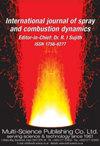Numerical investigation of the response of turbulent swirl non-premixed flames to air flow oscillations
IF 2.1
4区 工程技术
Q3 ENGINEERING, MECHANICAL
International Journal of Spray and Combustion Dynamics
Pub Date : 2022-08-29
DOI:10.1177/17568277221114944
引用次数: 0
Abstract
The response of swirl non-premixed flames to air flow oscillations is studied using Large-Eddy Simulation (LES) and the Conditional Moment Closure (CMC) combustion model, focusing on the physical mechanisms leading to the heat release rate oscillations observed in a parallel experimental study. Cases relatively close to blow-off and characterized by different amplitude of the flow oscillations are considered. Numerical results are in good agreement with the experiment in terms of both mean flame shape and heat release rate response. Simulations show that the oscillation of the air flow leads to an axial movement and fragmentation of the flame that are more pronounced with increasing amplitude of the forcing. The flame response is characterized by fluctuations of the flame area, time-varying local extinction and lift-off from the fuel injection point. LES-CMC, due to the inherent capability to capture burning state transitions, predicts properly the flame transfer function as a function of the amplitude of the air flow oscillations. This suggests that the response mechanism for this flame is not only due to time-varying flame area, but also local extinction and re-ignition. This study demonstrates that LES-CMC is a useful tool for the analysis of the response of flames of technical interest to large velocity oscillations and for the prediction of the flame transfer function in conditions close to blow-off.湍流旋流非预混火焰对气流振荡响应的数值研究
使用大涡模拟(LES)和条件矩闭合(CMC)燃烧模型研究了涡流非预混火焰对气流振荡的响应,重点研究了在平行实验研究中观察到的导致放热率振荡的物理机制。考虑了相对接近吹出并且以不同振幅的流动振荡为特征的情况。从平均火焰形状和热释放速率响应两方面来看,数值结果与实验结果吻合较好。模拟结果表明,气流的振荡会导致火焰的轴向运动和碎裂,这种运动和碎裂随着强迫幅度的增加而更加明显。火焰响应的特征是火焰面积的波动、时变的局部熄灭和从燃料喷射点起飞。由于LES-CMC具有捕捉燃烧状态转变的固有能力,因此可以正确地预测作为气流振荡幅度函数的火焰传递函数。这表明,这种火焰的响应机制不仅是由于火焰面积的时变,而且是由于局部熄灭和重新点燃。这项研究表明,LES-CMC是一种有用的工具,可用于分析具有技术意义的火焰对大速度振荡的响应,并用于预测接近吹出条件下的火焰传递函数。
本文章由计算机程序翻译,如有差异,请以英文原文为准。
求助全文
约1分钟内获得全文
求助全文
来源期刊

International Journal of Spray and Combustion Dynamics
THERMODYNAMICS-ENGINEERING, MECHANICAL
CiteScore
2.20
自引率
12.50%
发文量
21
审稿时长
>12 weeks
期刊介绍:
International Journal of Spray and Combustion Dynamics is a peer-reviewed open access journal on fundamental and applied research in combustion and spray dynamics. Fundamental topics include advances in understanding unsteady combustion, combustion instability and noise, flame-acoustic interaction and its active and passive control, duct acoustics...
 求助内容:
求助内容: 应助结果提醒方式:
应助结果提醒方式:


